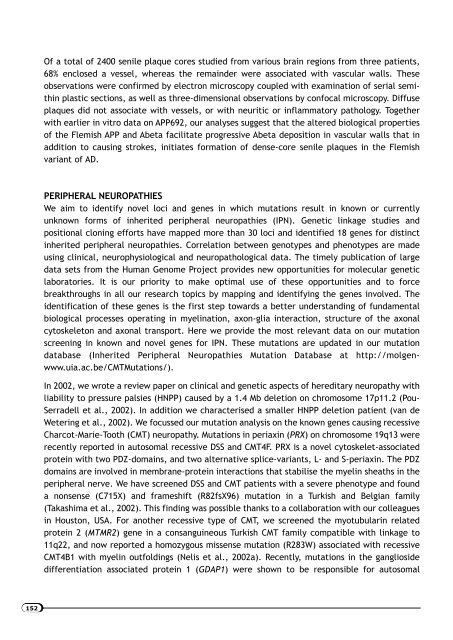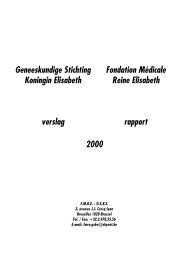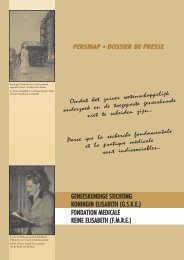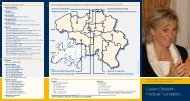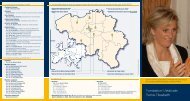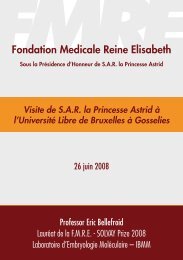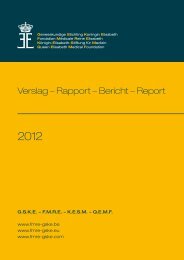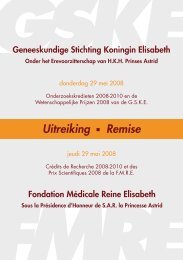Geneeskundige Stichting Koningin Elisabeth verslag - GSKE - FMRE
Geneeskundige Stichting Koningin Elisabeth verslag - GSKE - FMRE
Geneeskundige Stichting Koningin Elisabeth verslag - GSKE - FMRE
You also want an ePaper? Increase the reach of your titles
YUMPU automatically turns print PDFs into web optimized ePapers that Google loves.
152<br />
Of a total of 2400 senile plaque cores studied from various brain regions from three patients,<br />
68% enclosed a vessel, whereas the remainder were associated with vascular walls. These<br />
observations were confirmed by electron microscopy coupled with examination of serial semithin<br />
plastic sections, as well as three-dimensional observations by confocal microscopy. Diffuse<br />
plaques did not associate with vessels, or with neuritic or inflammatory pathology. Together<br />
with earlier in vitro data on APP692, our analyses suggest that the altered biological properties<br />
of the Flemish APP and Abeta facilitate progressive Abeta deposition in vascular walls that in<br />
addition to causing strokes, initiates formation of dense-core senile plaques in the Flemish<br />
variant of AD.<br />
PERIPHERAL NEUROPATHIES<br />
We aim to identify novel loci and genes in which mutations result in known or currently<br />
unknown forms of inherited peripheral neuropathies (IPN). Genetic linkage studies and<br />
positional cloning efforts have mapped more than 30 loci and identified 18 genes for distinct<br />
inherited peripheral neuropathies. Correlation between genotypes and phenotypes are made<br />
using clinical, neurophysiological and neuropathological data. The timely publication of large<br />
data sets from the Human Genome Project provides new opportunities for molecular genetic<br />
laboratories. It is our priority to make optimal use of these opportunities and to force<br />
breakthroughs in all our research topics by mapping and identifying the genes involved. The<br />
identification of these genes is the first step towards a better understanding of fundamental<br />
biological processes operating in myelination, axon-glia interaction, structure of the axonal<br />
cytoskeleton and axonal transport. Here we provide the most relevant data on our mutation<br />
screening in known and novel genes for IPN. These mutations are updated in our mutation<br />
database (Inherited Peripheral Neuropathies Mutation Database at http://molgenwww.uia.ac.be/CMTMutations/).<br />
In 2002, we wrote a review paper on clinical and genetic aspects of hereditary neuropathy with<br />
liability to pressure palsies (HNPP) caused by a 1.4 Mb deletion on chromosome 17p11.2 (Pou-<br />
Serradell et al., 2002). In addition we characterised a smaller HNPP deletion patient (van de<br />
Wetering et al., 2002). We focussed our mutation analysis on the known genes causing recessive<br />
Charcot-Marie-Tooth (CMT) neuropathy. Mutations in periaxin (PRX) on chromosome 19q13 were<br />
recently reported in autosomal recessive DSS and CMT4F. PRX is a novel cytoskelet-associated<br />
protein with two PDZ-domains, and two alternative splice-variants, L- and S-periaxin. The PDZ<br />
domains are involved in membrane-protein interactions that stabilise the myelin sheaths in the<br />
peripheral nerve. We have screened DSS and CMT patients with a severe phenotype and found<br />
a nonsense (C715X) and frameshift (R82fsX96) mutation in a Turkish and Belgian family<br />
(Takashima et al., 2002). This finding was possible thanks to a collaboration with our colleagues<br />
in Houston, USA. For another recessive type of CMT, we screened the myotubularin related<br />
protein 2 (MTMR2) gene in a consanguineous Turkish CMT family compatible with linkage to<br />
11q22, and now reported a homozygous missense mutation (R283W) associated with recessive<br />
CMT4B1 with myelin outfoldings (Nelis et al., 2002a). Recently, mutations in the ganglioside<br />
differentiation associated protein 1 (GDAP1) were shown to be responsible for autosomal


